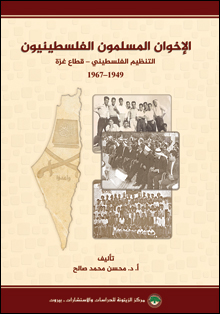Al-Zaytouna Centre for Studies and Consultations has published a new Arabic book entitled, “The Palestinian Muslim Brothers: The Palestinian Organization –Gaza Strip 1949–1967, by Prof. Dr. Mohsen Mohammad Saleh. The 398-page book consists of five chapters and appendices of documents and photos. It provides a complete picture of the “Palestinian organization” during the 1949–1967 period, in addition to much information published for the first time.
It is a scientific study that was subject to the conditions of scientific research and its methods, and its chapters were peer-reviewed and academically approved. The author has endeavored to collect the information from their original sources as much as possible. He benefited greatly from oral history, where he conducted dozens of interviews with a group of Palestinian Islamic figures and symbols, who held leadership roles in the 1950s and 1960s. He met the interviewees in their country of residence; in Jordan, Kuwait, Saudi Arabia, the Emirates and Lebanon. He also exchanged correspondence with a number of personalities and leaders in the West Bank (WB) and Gaza Strip (GS). The author also relied on dozens of Arab and foreign references and sources.
| Click here to download:
>> The Palestinian Muslim Brothers: The Palestinian Organization – Gaza Strip 1949-1967 (Arabic) |
| Publication Information Arabic – Title: AL-Ikhwan al-Muslimun al-Filastiniyyun: Al-Tanthim al-Filastini – Qita‘ Ghazzah 1949–1967 (The Palestinian Muslim Brothers: The Palestinian Organization – Gaza Strip 1949-1967). – Prepared by: Prof. Dr. Mohsen Mohammad Saleh – Published in: 2020 – Hard Cover: 398 pages. – Price: $17 – ISBN: 978-9953-572-88-8 |
 |
The book studies the experience of the Palestinian Muslim Brothers (MB) in GS in the 1949–1967 period, and the emergence of the Palestinian MB movement, and its expansion to include the Palestinians in the Arab countries, except for Jordan. The first chapter is an introductory one that talks about the Palestinian MB and the Arab environment during that period. It depicts the general conditions of the Palestinian scene and the MB movement and its role in the 1948 war. Chapter two discusses the Palestinian MB movement in GS during the 1949–1956 period, while chapter three covers that movement during the 1957–1967 period and its restructuring to include the Palestinian MB in the Arab countries except Jordan. In addition to the establishment of the movement in GS, chapter three explains the activities in three countries: Egypt, Kuwait and Syria. As for chapter four, it focuses on the MB military action during the 1949–1956 period, highlighting its leading role in Palestinian resistance. The last chapter, chapter five, discusses the Palestinian MB role in the establishment of the Fatah movement.
This book displays many photos that hold special historical value. They include the most prominent figures and events of that phase. Each chapter has its own photo appendix.
This book clears many ambiguities and distortions concerning the role of the Palestinian MB during the 1950s and 1960s, which were initially due to the fact that they did not record their experiences, while the others wrote their memoirs of that period, reflecting their ideological backgrounds, or their experiences through the political and social milieu in which they lived, which was away from the Islamists or in many cases had different levels of friction, where some held a negative attitude. In addition, many of the important scientific studies of that period reflected the circulating literature and narratives in which the Islamists were largely absent or the authors were unable to reach them.
Consequently, al-Zaytouna Centre hopes that this book will fill an important gap in Palestinian studies and modern Palestinian history, and that it constitutes a qualitative addition to academic studies related to Palestine and its issue.






 ||
||

Leave A Comment